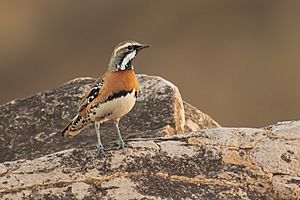Chestnut-breasted quail-thrush facts for kids
Quick facts for kids Chestnut-breasted quail-thrush |
|
|---|---|
 |
|
| Conservation status | |
| Scientific classification | |
| Genus: |
Cinclosoma
|
| Species: |
castaneothorax
|
The chestnut-breasted quail-thrush (Cinclosoma castaneothorax) is a small bird found only in Australia. It mostly lives in the dry, desert-like areas of New South Wales, Queensland, and Western Australia.
Where They Live
The chestnut-breasted quail-thrush can be found in northwestern New South Wales, western Queensland, and many parts of Western Australia. They prefer dry areas, also called semi-arid zones. These places have scattered woody shrubs, small plants, and grassy mounds.
Family Life
These birds usually lay their eggs during the winter. They often lay eggs at the end of months that have had a lot of rain earlier on.
Building a Nest
The chestnut-breasted quail-thrush typically lays two eggs at a time. Their nest is built on the ground in a small dip. It's usually about 5 cm deep and 15 cm wide. They make their nests from mulga leaves and hop-bush bark.
The nests are hidden among low hop bushes. These bushes are often found near mulga trees. The nest is usually covered by a curtain of leaves and bark, keeping it safe.
Older and younger birds from the same family often visit the nest. However, only the adult birds feed the baby birds. If young birds get too close to the nest, the adult male might chase them away. Young birds are smaller and have a less complete bar on their chest.
All birds near the nest, even the newly hatched chicks, stay very still if predators are around. Predators include birds like crows and the large wedge-tailed eagle. Chestnut-breasted quail-thrushes are also known to chase away other birds. These include crested bellbirds, grey-crowned babblers, chestnut-crowned babblers, and Hall's babblers.
What They Sound Like
- Common call: A whistling sound with two or three short notes. Only the male bird makes this sound.
- When alarmed: They make one or two insect-like noises. This sound is similar to the Myzomela nigra bird. Both male and female birds make this sound when they are worried.
Bird Families
Scientists group birds like the chestnut-breasted quail-thrush into families. The Cinclosoma group has two main clusters of birds that are related.
The first cluster includes the chestnut-breasted quail-thrush and a few close relatives. These birds became different species because they lived in separate parts of Australia's deserts.
The second cluster includes other Cinclosoma birds that are less closely related. These birds became different species because they lived in areas that were next to each other, like dry areas next to wet areas.
It is thought that all Cinclosoma birds came from a common ancestor. This ancestor lived in Australia's warm, wet forests a long time ago. As Australia's climate changed, their descendants spread across the deserts. This is why many of the desert Cinclosoma birds have camouflage feathers. These feathers help them blend in with their surroundings.
See also
 In Spanish: Zordala pechicastaña para niños
In Spanish: Zordala pechicastaña para niños


